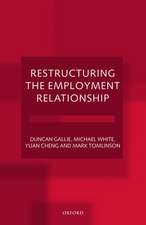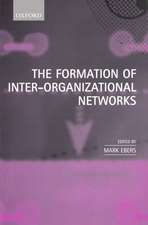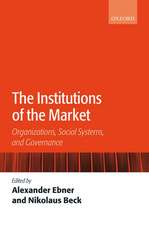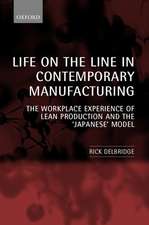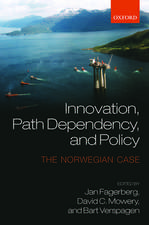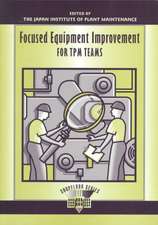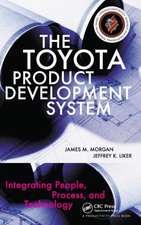Dynamic Locational Phases of Economic Activity in the Globalized World
Autor Toshiharu Ishikawaen Limba Engleză Paperback – 25 apr 2018
| Toate formatele și edițiile | Preț | Express |
|---|---|---|
| Paperback (1) | 380.84 lei 6-8 săpt. | |
| Springer Nature Singapore – 25 apr 2018 | 380.84 lei 6-8 săpt. | |
| Hardback (1) | 387.96 lei 6-8 săpt. | |
| Springer Nature Singapore – 23 mar 2016 | 387.96 lei 6-8 săpt. |
Preț: 380.84 lei
Nou
Puncte Express: 571
Preț estimativ în valută:
72.87€ • 76.09$ • 60.18£
72.87€ • 76.09$ • 60.18£
Carte tipărită la comandă
Livrare economică 15-29 aprilie
Preluare comenzi: 021 569.72.76
Specificații
ISBN-13: 9789811091827
ISBN-10: 981109182X
Ilustrații: XIII, 152 p. 70 illus., 25 illus. in color.
Dimensiuni: 155 x 235 mm
Greutate: 0.25 kg
Ediția:Softcover reprint of the original 1st ed. 2016
Editura: Springer Nature Singapore
Colecția Springer
Locul publicării:Singapore, Singapore
ISBN-10: 981109182X
Ilustrații: XIII, 152 p. 70 illus., 25 illus. in color.
Dimensiuni: 155 x 235 mm
Greutate: 0.25 kg
Ediția:Softcover reprint of the original 1st ed. 2016
Editura: Springer Nature Singapore
Colecția Springer
Locul publicării:Singapore, Singapore
Cuprins
Part I Location theory of retailingindustry.- 1 Market areas of retailers in linear space.- 1.1 Formationmechanism of monopoly retailer’s market.- 1.2 Emergence of competition andcompetition styles.- 1.3 Equilibrium price and market established in linearmarket.- 2 Market areas of retailers in plane space.- 2.1 Shapes of marketborder between two retailers.- 2.2 Market area in spatial free entryequilibrium.- 2.3 Effects of variety of items on retailer’s market situation.-2.4 Effects of freight rate on items and market of shopping center.- 3 Marketanalysis by Contact Price Curve.- 3.1 Derivation of spatial free-entryequilibria.- 3.2 Analysis of spatial free-entry equilibria by using contactprice curve.- Part II Location theory of manufacturing industry.- 4 Change offactory’s production in agglomeration.- 4.1 Formation of industrialagglomeration.- 4.2 Relationship between number of factories and agglomerationeconomies.- 4.3 Spatial departure of production processes from agglomeration.-5 Location theory of factory in the globalized world.- 5.1 Factory’s locationin the globalized world.- 5.2 Derivation of the profit function of a firm.- 5.3Settlement of location prospective area.- 5.4 Firm’s profits and revenues ofcountries in different corporation tax rates.- 5.5 Location power of thecorporation tax and the interest rate.- 5.6 Effects on factory’s location ofindustrial park and industrial complex.- Part III Location theory of citysystem.- 6 City systems built on basis of economic activity.- 6.1 City systemsconstructed on basis of market area theory.- 6.2 City system built by usingcities’ production functions.- 6.3 Change of city system in the real world.- 7Analysis of city system by using cities’ land rents.- 7.1 Assumptions andframework of analysis.- 7.2 Land rent and capital amount in city.- 7.3 Analysisof Land rents and production amounts of cities in city system.- 7.4 Influencesof change of freight rates and production efficiency on cities.- 8 City systemas a location factor.- 8.1 Role of city system in firm’s decision making oflocation.- 8.2 Numerical index of characteristics of city system.- 8.3Estimation of social health of prefectures in Japan.- 8.4 Relationships betweencity system and prefecture’s performances.- 8.5 City system as a locationfactor.- Appendix.- References.
Notă biografică
ToshiharuIshikawa, Facultyof Economics, Chuo University, Tokyo, Japan
Textul de pe ultima copertă
This book clarifies the mechanisms of economicglobalization in changing industries’ locations and shows how industries’ locations have changedthrough those mechanisms. First, the book deals with the retailing industry.Introducing the concept of a contactprice into the market area analysis, it is shown in Part I that retailers’market areas and prices are changed in different ways by a reduction oftransportation costs. The mechanism of these changes is explained by checkingthe contact prices at apexes of the retailers’ market areas. Then the book movesto the manufacturing industry and deals with a firm’s production process. Part IIof the book shows the manner in which the production volume of factories withinan agglomeration is decreased as the number of factories within theagglomeration increases. Subsequently, considering the fact that many productionfactories depart from agglomerations to other sites to reduce production costs,a method of searching for a factory’s new site is proposed in which a firm can seekout an optimal location of a factory in a short period of time. By referring toa chaotic phenomenon, a firm sets a locationprospective area in a large geographical area and selects an optimallocation within that area. In the third part of the book the city system is thefocus. Part III elucidates the theoretical formation of a city system andanalyzes structural changes of a city system due to a reduction oftransportation costs. The mechanism of the change is explained by a flexible market area theory which studiesa city system by using the market areas established in the free-entry equilibrium.Then, the economic relationships between the cities within a city system areexamined from the point of view of the land rent in the cities’ areas. Thisanalysis shows the influences of a change in the largest city on other cities. Finally,the relationships between a city system and regional performance are examinedusing real data.The examination shows that the city system reveals the regionalperformance.
Caracteristici
Elucidates the mechanisms in which locations of the retail and manufacturing activities vary due to economic globalization Explains the location determination process by which firms determine a factory’s location site in a large area by using a chaotic phenomenon Shows the reformation of the city system by analyzing the changes in the retailers’ market area sizes Includes supplementary material: sn.pub/extras

